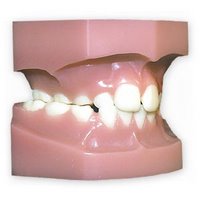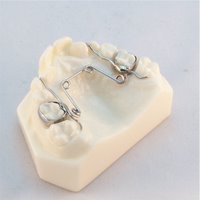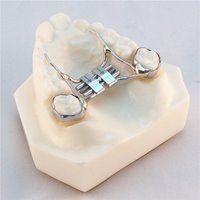If the upper arch of teeth is too constricted, you know, more like a narrow "V" than a fat "U" then the upper teeth may not fit over the lower teeth. If the back teeth are "crossed" then it is a posterior crossbite. The ideal arch shown here has all the upper teeth just over the bottom teeth. In the constricted arch, one side has shifted into crossbite and now fits to the inside of the bottom teeth. This can be unilateral or one sided or bilateral consisting of a crossbite on both sides. The effect of this is to accentuate crowding. It may also affect the positioning of the mandible into a shift or off-center bite. During growth this may lead to asymmetry*. Crossbites in general can be back teeth or front teeth. It may affect one tooth or all teeth. It can be caused by prolonged thumb or finger sucking, pacifier sucking, restricted airway from large adenoids and tonsils leading to mouth breathing and also can occur due to other genetic and developmental causes. An anterior crossbite effects the front teeth. More on that here: Anterior Crossbite
A crossbite will almost never correct itself with growth. It can affect primary teeth and permanent teeth. If the whole side of a primary dentition is in crossbite, there is a chance of the permanent six year molar erupting into crossbite as well. A bilateral crossbite is even more severe. Correction is usually recommended. Most any age can be treated, preschoolers through adults.
 Treatment usually consists of expansion of the upper arch back to the "U" shape allowing the teeth to fit properly and allowing more room for the correction of crowding. Expansion like this is often part of more comprehensive orthodontic treatment (braces). There are many types of orthodontic appliances used to correct this kind of bite problem. If the only treatment goal is to correct the posterior crossbite, then only a few months of treatment is needed. Once the crossbite is corrected, you usually leave the appliance in there a few extra months so it won't relapse after removal. Expansion is fairly easy in growing children. There is a suture or natural division in the left and right bones of the palate. After you separate the bones, they will grow together again in the new position. All this is a slow process and is not uncomfortable except getting used to the appliance in the mouth. Usually a course of treatment is about 6 months, although that can vary.
Treatment usually consists of expansion of the upper arch back to the "U" shape allowing the teeth to fit properly and allowing more room for the correction of crowding. Expansion like this is often part of more comprehensive orthodontic treatment (braces). There are many types of orthodontic appliances used to correct this kind of bite problem. If the only treatment goal is to correct the posterior crossbite, then only a few months of treatment is needed. Once the crossbite is corrected, you usually leave the appliance in there a few extra months so it won't relapse after removal. Expansion is fairly easy in growing children. There is a suture or natural division in the left and right bones of the palate. After you separate the bones, they will grow together again in the new position. All this is a slow process and is not uncomfortable except getting used to the appliance in the mouth. Usually a course of treatment is about 6 months, although that can vary.
One fixed appliance is a contraption that the patient (parent) uses a key to turn a small screw little by little every day. I prefer a Quad helix, which is kind of spring loaded and the parent doesn't have to do anything. Which one to use is based on the specific case. There are removable appliances as well (like retainers), but cooperation becomes a bigger issue there. Here are a few photos of a quad helix and a variant of an RPE (the thing with the screw), photos courtesy of QC Orthodontics Lab. The design I use is similar but a little different than these.

If you've read this far, here's some more info:When is the best time to start Braces?.
*A well done recent study tends to confirm the benefits of correction of functional posterior crossbites especially in the mixed dentition (ie. they still have some of their baby teeth):
Kecik D, Kocadereli I, Saatci I. Evaluation of the Treatment Changes of Functional Posterior Crossbite in the Mixed Dentition. American Journal of Orthodontics and Dentofacial Orthopedics 2007; 131 (February): 202-215.
A crossbite will almost never correct itself with growth. It can affect primary teeth and permanent teeth. If the whole side of a primary dentition is in crossbite, there is a chance of the permanent six year molar erupting into crossbite as well. A bilateral crossbite is even more severe. Correction is usually recommended. Most any age can be treated, preschoolers through adults.
 Treatment usually consists of expansion of the upper arch back to the "U" shape allowing the teeth to fit properly and allowing more room for the correction of crowding. Expansion like this is often part of more comprehensive orthodontic treatment (braces). There are many types of orthodontic appliances used to correct this kind of bite problem. If the only treatment goal is to correct the posterior crossbite, then only a few months of treatment is needed. Once the crossbite is corrected, you usually leave the appliance in there a few extra months so it won't relapse after removal. Expansion is fairly easy in growing children. There is a suture or natural division in the left and right bones of the palate. After you separate the bones, they will grow together again in the new position. All this is a slow process and is not uncomfortable except getting used to the appliance in the mouth. Usually a course of treatment is about 6 months, although that can vary.
Treatment usually consists of expansion of the upper arch back to the "U" shape allowing the teeth to fit properly and allowing more room for the correction of crowding. Expansion like this is often part of more comprehensive orthodontic treatment (braces). There are many types of orthodontic appliances used to correct this kind of bite problem. If the only treatment goal is to correct the posterior crossbite, then only a few months of treatment is needed. Once the crossbite is corrected, you usually leave the appliance in there a few extra months so it won't relapse after removal. Expansion is fairly easy in growing children. There is a suture or natural division in the left and right bones of the palate. After you separate the bones, they will grow together again in the new position. All this is a slow process and is not uncomfortable except getting used to the appliance in the mouth. Usually a course of treatment is about 6 months, although that can vary.One fixed appliance is a contraption that the patient (parent) uses a key to turn a small screw little by little every day. I prefer a Quad helix, which is kind of spring loaded and the parent doesn't have to do anything. Which one to use is based on the specific case. There are removable appliances as well (like retainers), but cooperation becomes a bigger issue there. Here are a few photos of a quad helix and a variant of an RPE (the thing with the screw), photos courtesy of QC Orthodontics Lab. The design I use is similar but a little different than these.


If you've read this far, here's some more info:When is the best time to start Braces?.
*A well done recent study tends to confirm the benefits of correction of functional posterior crossbites especially in the mixed dentition (ie. they still have some of their baby teeth):
Kecik D, Kocadereli I, Saatci I. Evaluation of the Treatment Changes of Functional Posterior Crossbite in the Mixed Dentition. American Journal of Orthodontics and Dentofacial Orthopedics 2007; 131 (February): 202-215.

Comments
Post a Comment